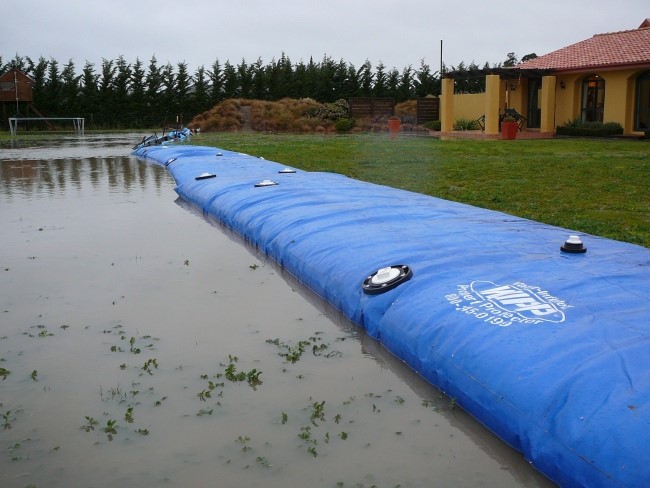Sometimes, it might not be possible to prevent a flood, even if we know that its about to get flooded. However, there are certain actions that can be taken to reduce the impact significantly, or, to reduce the possibility of flooding:
1. The first step is to keep the drainage system clean. This allows water to be carried down very fast. Choked drains cause a significant reduction in the ability and speed of the water to be drained away. In most situations of urban flooding – this is a major cause. The drains might get choked due to throwing of solid-wastes inside storm drains. These solid-wastes might include construction material, plastics, paper etc. This is a clear example, how human activity can amplify the process of flooding. Drains might also get choked due to falling tree-leaves etc.
2. General clean-up of streets is also important. As rain-water falls down the street, it rushes into the storm drains. if the streets are not clean, the rain water trying to go into the drain – carries solid wastes into the drain with itself, which then obstructs the flow of water by the drainage system.
3. Rain water harvesting system: As more rain-water tries to flow down the drains, it puts that much more stress on the drainage system. Instead, if there are several rain-water harvesting systems, the rainfall falling in that much area would try to go to the sub-soil of the region locally, rather than straining the drainage system. Lower is the amount of water trying to go through the drainage system, the easier it is for the drainage system to drain off the water.
4. Desilting: The drains should be desilted before the onset of the rainy season. This prevents the drains from getting choked. And, it also inceases the holding capacity of the drain, as, accumulated silt prevents that much more water from being accumulated in the drains.
5. Inspection and repair of dams, levees, embankments etc: Before the onset of seasons causing accumulation and/or carrying of heavy volume of water (such as rainy season), these structures should be thoroughly inspected for possible weak-spots, and, these should be repaired.
6. Afforestation: Forestation helps in binding the loose soil. The most major impact of this is, as flood-water races through, it might take loose soil with it. This loose soil will now choke the drains, as well as water-harvesting systems, thus, rendering both of these as ineffective. On the other hand, trees will prevent soil to flow with the water, as, the roots of the trees will act as binding force. Another major impact that afforestation provides is by reducing the impact of flowing water. This has impact on large-scale flooding, such as overflowing river. As water charges forward, its speed is reduced to some extent due to resistance offered by trees. This can reduce the force of the charging water – thereby, reducing structural damage – due to weakening in the force with which water hits various structures.
7. Local lowlands (say: foot of an overbridge) should have storm drains, so that water does not get accumulated there. These drains should have some kind of mesh covering, so that only water can flow in. Leaves and other solid debris should not go in these drains.
8. Local embankments around low-lying houses etc: Lets say, for some reason, your house is at a level lower than its vicinity (e.g. road-level). This can happen, because, say: you have constructed a basement – which is obviously lower than the road-level, or, over a period of years, the road-level has risen due to repeated tarring etc. In such cases, you should create a “local” embankment between the street/road and your property, so that water can not flow “down” from the street/road inside your house. These embankment might be permanent – in the form of concrete structure.
Besides impacting the process of flooding itself, most (not all) of these factors also have an immense impact on the rate at which water levels might recede – after the source of the flooding has been removed. e.g. Lets say a city got flooded, after heavy rainfall. Now, once the rainfall is stopped, the water levels in the streets etc. might tend to recede. At this stage, once again, the rate at which water levels can recede is dependent on the ability of the storm drains to carry the accumulated water, as well as the total amount of water that has been accumulated – which needs to be drained out.
Being Prepared
People who stay in flood-prone areas should construct their houses using material which does not get damaged severely due to flood-water. Also, since, there is a strong risk of structural damage (for large-scale flooding), the material used to construct the house should be such that it can withstand high impact – due to the charge of flowing water. One should prefer areas, which are slightly elevated. These could be local elevations, i.e. higher parts of the city etc. There should be strong embankments along all entrances of the houses – so that flood water does not enter the house easily.
Cement bags, covered with plastic sheets might be used to keep the flood water from entering the houses.
Besides, long boots should always be kept, so that one does not run the risk of being bitten by snakes and/or other insects that might also be trying to save themselves from the twirling flood-waters.
One should keep arrangements for raising the height of items, which might get damaged in water, e.g. put a few pieces of bricks below the legs of the furniture, such as bed etc. to raise its height.
Important document should always be kept on higher shelves.
As water, food and utilities would not be available – and that too – for possibly several days, one should also take measures towards General Preparedness
Macro Level Efforts
While some of the steps mentioned above need to be taken at municipal/city level, and, some at individual level, there are some other techniques which have been tried/used at some places. However, these require efforts at a much larger level. Some of these steps include:
● Identified flood diversion areas: Flood waters are diverted to these unpopulated areas, so that populated urban areas may be protected.
● Construction of dams etc. at strategic locations
● Levees, embankments around cities lying along river/sea coasts. The flooding of New Orleans – in the aftermath of Katrina hurricane was due to a breach in such a levee.
● Sea walls
● Beach nourishment: The sea-beaches are widened, so that they can absorb the impact of flood-waters – due to rise in sea-levels.
● Conversion of flood-prone areas into wetlands, where, urbanization is not allowed, i.e. one can not construct residential houses, or, any other permanent structures etc.
As can be seen, such efforts require a very high degree of financial commitment, not just for constructing the system, but, also for maintaining it.


